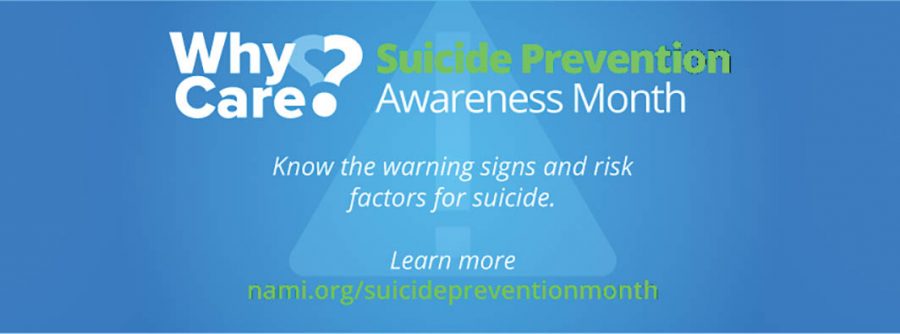Suicide Prevention Awareness month urges serious conversation
On average, 120 suicides occur every day. Numbers have continued to rise over the past few years.
September is National Suicide Prevention Awareness Month. The long-lasting stigma surrounding suicide and those with mental health issues have hampered the discussion with how to raise awareness, educate and reach out to people in need.
Great strides have been made in the last few decades in regard to the discussion surrounding suicide and other mental health issues. But there is still a lack of understanding and direct connection for people that have never lost someone to suicide or experienced suicidal thoughts themselves.
There has always been a negative connotation with suicide and the way people address it; however, in recent years our youth have used suicide as a means of humor, not realizing the impact it has on those who struggle with it.
I have heard sick jokes time and time again like “Oh my god, this math homework is so annoying I’m gonna kill myself,” or “This teacher is annoying me so much I’m gonna throw myself off the first floor.” It got to the point that I confronted them about it, just to find out none of them were even remotely suicidal. So why make jokes like that?
Suicide, for those who do not have experience with it firsthand, is often seen and treated as a joke since it may be difficult to see the reasoning behind it, which can lead to serious issues. On average, there are 129 suicides every day. The number has continued to rise over the last few years. To call the situation an epidemic would be an understatement. Although there are so many deaths from it every day, there are still very few people who know the truth.
One main problem that could arise is that if a person believes that someone will not go through with killing themselves, they may bully or tease them about it until it is too late and they realize that the person had intended to. Their actions could be the last straw when they could have gone another route and potentially saved a life.
Just because you may not believe someone is suicidal because they have a fantastic life, good looks or a lot of money does not mean anything. There are many other external and internal factors that could be the cause.
Either way, the cause is not the most important part, but instead, it is the acceptance of it and willingness from others around to help. Dedicating the month of Sept. to raising awareness for suicide prevention will hopefully open the public’s eyes to the truth, and in turn, save more lives.
If you know someone who you believe may be planning to commit suicide, use the QPR method: Question. Persuade. Refer. First, ask that person if they are thinking of, are planning to, or have a plan to commit suicide. Remember that asking someone if they are thinking about committing suicide will never put the idea in their head. If they are planning to, then the idea was already there.
Next, persuade. Show that you are there for that person, that you care for them and that someone is looking out for them. Lastly, refer. When someone’s life is at stake, having that person mad at you temporarily for referring them to a resource is much better than losing them forever. There are also warning signs that people who may be suicidal will show: changes in eating and sleeping habits, giving away prized possessions, and saying things like, “I can’t live without you,” or “It doesn’t matter anymore.”
Something important to remember is not everyone who commits suicide will display warning signs or have a history of depression. That is why it is so important to help educate people about suicide, to help eliminate stigma, and create a safer environment so that people can feel open to discussing what they are going through.







